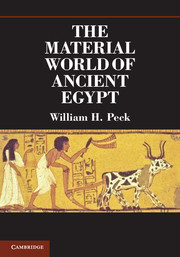Book contents
- Frontmatter
- Contents
- List of Figures
- Preface
- Acknowledgments
- Introduction
- 1 Geography and Geology
- 2 Brief Outline of Egyptian History
- 3 Study of the Material World of Ancient Egypt
- 4 Dress and Personal Adornment
- 5 Housing and Furniture
- 6 Food and Drink
- 7 Hygiene and Medicine
- 8 Containers of Clay and Stone
- 9 Tools and Weapons
- 10 Basketry, Rope, Matting
- 11 Faience and Glass
- 12 Transportation
- 13 Sport and Games
- 14 Music and Dance
- 15 Weapons and Armor
- 16 Conclusions
- Sources of Chapter Heading Quotations
- Bibliography
- Index
14 - Music and Dance
Published online by Cambridge University Press: 05 August 2013
- Frontmatter
- Contents
- List of Figures
- Preface
- Acknowledgments
- Introduction
- 1 Geography and Geology
- 2 Brief Outline of Egyptian History
- 3 Study of the Material World of Ancient Egypt
- 4 Dress and Personal Adornment
- 5 Housing and Furniture
- 6 Food and Drink
- 7 Hygiene and Medicine
- 8 Containers of Clay and Stone
- 9 Tools and Weapons
- 10 Basketry, Rope, Matting
- 11 Faience and Glass
- 12 Transportation
- 13 Sport and Games
- 14 Music and Dance
- 15 Weapons and Armor
- 16 Conclusions
- Sources of Chapter Heading Quotations
- Bibliography
- Index
Summary
The noble, Imyhsetj, playing the pipe very well.
Playing the flute for your Ka every day.
Captions to tomb scenes
Music and Musical Instruments
What is usually defined as music is basically sound and rhythm organized in time, and virtually all cultures and societies have or have had some form of it. In Music and the Mind Anthony Store made the observation that in every culture music serves as a device or tool to bring people together in common activities. Repeated rhythms serve to unite participants in recreation and ritual, organize troops on the march, and coordinate the efforts of workers in the fields. Anyone who has ever seen the effects of the “call and response” work songs of field hands, where a leader sings or chants a verse and the workers respond with a chorus, can attest to their rhythmic results.
One of the most serious obstacles to an understanding of ancient Egyptian music is the almost complete absence of any preserved musical notation in the form of written music. There is at least one exception, but one that is not much help. This is a small statue of a harpist depicted with an open manuscript before him. The page has the remains of some symbols on it, probably representing some direction as to how he was to play. Even though it is not very helpful, this object does prove that there may have been a system of written music. However, preserved evidence of musical notation and writings about music theory in Egypt are not well attested until the time of the Greeks.
- Type
- Chapter
- Information
- The Material World of Ancient Egypt , pp. 180 - 191Publisher: Cambridge University PressPrint publication year: 2013

